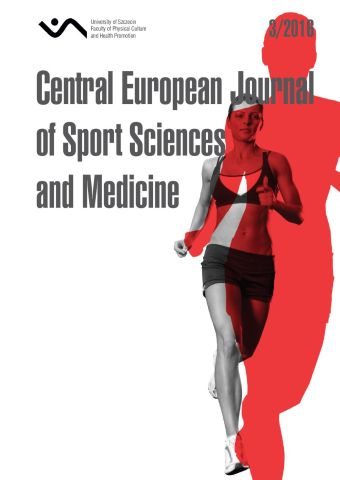
ISSN: 2300-9705
eISSN: 2353-2807
OAI
DOI: 10.18276/cej.2016.3-07




Lista wydań /
Vol. 15, No. 3/2016
Time Analysis of Muscle Activation during Basketball Free Throws
| Autorzy: |
Paweł
Pakosz
Faculty of Physical Education and Physiotherapy, Opole University of Technology, Poland Mariusz Konieczny Faculty of Physical Education and Physiotherapy, Opole University of Technology, Poland |
| Słowa kluczowe: | throw efficiency EMG stage of training |
| Data publikacji całości: | 2016 |
| Liczba stron: | 7 (63-69) |
Abstrakt
Objective of the study: The study assessed and compared the duration of the muscle activation in a basketball free throw, by players representing a preliminary and specialist stage of training. There was also analysed the accuracy of throws according to the stage of training, and whether individual changes in duration of activation have impact on the accuracy of free throws. Material and methods: Players from national basketball teams second and third league of the AZS Academic Sports Club of Opole University performed twenty free throws shooting to the basket during the research study. During tests, players were equipped with EMG apparatus, which registered the time of muscle activation, when subsequent free throws were performed. Arm muscle (biceps and triceps) activation time was measured from the beginning of muscle activation to the time of completion of their work, and from muscle activation to the time of reaching the rim.Results: Players of specialist stage of training, have 0,30 sec shorter average arm muscle time activation, counted from the beginning of activation to obtain the minimum value, from players of the preliminary stage of training. They also gained average 2 points better result in throw accuracy. Variability coefficient of throws duration was higher by 19.56% at players of the specialist stage of training. In the case of unforced extend duration of muscle activation, 80% of specialists and 40% players of preliminary group, don’t score the basket.Conclusions: It was observed that the basketball players of higher training experience, have lower average time of arm muscle activation. It was demonstrated that in players of the specialist stage of training, missed free throws were mostly caused by longer duration from the beginning of muscle activity to the rim, with players of the preliminary stage it was reverse.
Pobierz plik
Plik artykułu
Bibliografia
| 1. | Abe, S., Nozawa T., Kondo T.A. (2009). Proposal of EMG – based training support system for basketball dribbling. Symposium on human interface 2009, held as part of HCI International. Lecture Notes in Computer Science, 5617, 459–465. |
| 2. | Argaj, G. (2005). Analýza Tréningového A Herného Zaťaženia Vo Vybraných Športových Hrách. Zborník Vedeckých Prác Katedry Hier, 65–68. |
| 3. | Button, C.H., MacLeod, M., Sanders, R., Coleman, S. (2003). Examining movement variability in the basketball freethrow action at different skill levels. Research Quarterly for Exercise and Sport, 74 (3), 257–269. |
| 4. | Gablonsky, J.M., Lang, A. (2005). Modeling basketball free throw. SIAM Review, 47 (4), 775–798. |
| 5. | Higgins, J.R., Spaeth, R.K. (1972). Relationship between consistency of movement and environmental condition. Quest, 17, 61–69. |
| 6. | Konrad, P. (2007). ABC of EMG. Practical introduction to kinesiological electromyography (pp. 40–46). Gliwice: Technomex. |
| 7. | Kornecki, S., Lenart, I. (1997). Analiza kinematyczna rzutu piłki do kosza z wyskoku. Wychowanie Fizyczne i Sport, 3, 79–99. |
| 8. | Kubaszczyk, A. (2001). Poziom koordynacyjnych zdolności motorycznych i umiejętności technicznych koszykarzy. Wychowanie Fizyczne i Sport, 4, 480–498. |
| 9. | Liu, S., Burton, A. (1999). Changes in basketball shooting patterns as a function of distance. Perceptual and Motor Skills, 89, 831–845. |
| 10. | Mack, M.G. (2001). Effects of time and movements of the preshot routine on free throw shooting. Perceptual and Motor Skills, 93, 567–573. |
| 11. | Mačura, P. (2007). Trestné hody a víťazstvo v basketbale žien. Zborník Vedeckých Prác Katedry Hier FTVŠ UK, 8, 56–61. |
| 12. | Mačura, P., Potocký, F. (2009). Vplyv herných činností jednotlivca na víťazstvo v basketbalovom zápase. Zborník Vedeckých Prác Katedry Hier FTVŠ UK, 14, 7–13. |
| 13. | Miller, S. (2001). Variability in basketball shooting: practical implications. In: Y. Hong (ed.), In International Research in Sports Biomechanics (pp. 27–34). London: Routledge. |
| 14. | Miller, S. (1999). Electromyographic considerations of inaccuracy in basketball shooting (pp. 209–212). In Scientific Proceedings of the XVII ISBS Symposium. |
| 15. | Tománek, Ľ., Vencúrik, T. (2008). Individualizácia hodnotenia tréningového a zápa-sového zaťaženia v basketbale (pp. 151–156). Na podporu projektov VEGA. |
| 16. | Wissel, H. (1994). Basketball: Steps to Success. Champaign: Human Kinetics. |
| 17. | Zatoń, M., Zatoń, K., Zygadło, A. (2008). Zmiany w zdolności kinestetycznego zróżnicowania w procesie uczenia się jazdy na nartach. Antropomotoryka, 44, 37–47. |
| 18. | Zuzik, P. (2011). Free Throw Shooting Effectiveness in Basketball Matches of Men and Women. Sport Science Review, 20 (3–4), 149–160. |
| 19. | Zwierko, T., Osiński, W. (2001). Indywidualne zróżnicowanie oraz czynniki determinujące skuteczność uczenia się w koszykówce kobiet studiujących wychowanie fizyczne. Antropomotoryka, 11 (22), 47–63. |
| 20. | Vickers, J.N. (1996). Visual control when aiming at a far target. Journal of Experimental Psychology, Human Perception and Performance, 22 (2), 342–354. |